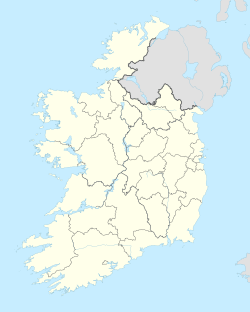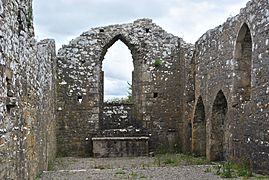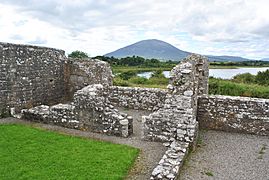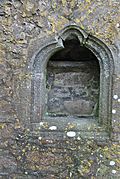Errew Abbey facts for kids
| Mainistir Oiridh | |
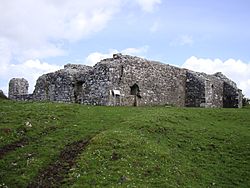 |
|
| Monastery information | |
|---|---|
| Other names | Aireach-lochacon; Aired-locha-con; Erew; Loch Conn; Oired; Oreab; |
| Order | Augustinians |
| Established | c. AD 500–520 |
| Disestablished | 1585 |
| Mother house | Crossmolina Priory |
| Diocese | Killala |
| People | |
| Founder(s) | Tigernan of Errew |
| Architecture | |
| Status | ruined |
| Style | Cistercian |
| Site | |
| Location | Errew, Castlehill, County Mayo |
| Coordinates | 54°03′11″N 9°15′48″W / 54.053131°N 9.263349°W |
| Public access | yes |
| Official name | Errew Abbey |
| Reference no. | 307 |
Errew Abbey is an old Augustinian monastery in County Mayo, Ireland. Today, it is a National Monument, which means it's a protected historical site.
Contents
Where is Errew Abbey?
Errew Abbey is found on a piece of land that sticks out into Lough Conn. This is a large lake in Ireland. Another old church, called Templenagalliaghdoo, is very close by, just to the north.
History of Errew Abbey
Early Beginnings
A holy person named Tigernan of Errew is believed to have started a monastery here. This was a very long time ago, around the early 500s AD. At first, it had a different name. It was called "Mainistir Taobh Thiar do Shruth," which means "the abbey on the west side of the stream."
This early monastery was a big learning center. It is said that as many as 1,400 students came here to study. They traveled from all over Europe to learn at Errew.
The Barrett Family's Influence
Later, in the 12th or 13th century, a powerful family called the Barretts helped to restart the monastery. They rebuilt and used the old buildings.
In 1404, Thomas Barrett, who was a Bishop (a high-ranking church leader) of Elphin, was buried at Errew Abbey.
In 1413, the Barretts founded a new abbey for the Augustinian Canons. These were a group of priests who lived together under special rules. This new abbey was dedicated to the Virgin Mary. It was probably more like a smaller church or "priory cell" that belonged to Crossmolina Abbey.
A Story of Sanctuary
In 1413, something interesting happened. A man named Henry Barrett found safety at Errew Abbey. Monasteries often offered "sanctuary," a safe place where people could not be harmed. However, McWattin Barrett broke this rule and took Henry away from the abbey.
Legend says that Saint Tigernan appeared to McWattin every night. This happened until McWattin promised to make things right. To apologize, he gave the abbey an éraic. This was a payment or gift to make up for a wrong deed. He gave them a piece of land called a "quarter of land" (ceathrú mír). This land was about 120 acres and was later known as Ballinbraher, or Friarstown.
Guardians of the Land
A family called O'Flynn were the "erenachs" of the lands around Errew. An erenach was a person who looked after church lands and property. They also owned a special item called Mias Tighernain. This was a paten, which is a plate used in church services. People believed it had belonged to Saint Tigernan himself.
The End of the Abbey
Errew Abbey continued until 1585. At this time, many monasteries in Ireland were "dissolved." This means they were officially closed down by the government. Their lands and buildings were taken away.
What the Building Looks Like Today
The main church building is long and rectangular. It measures about 27 meters (90 feet) long and 7 meters (22 feet) wide. You can still see some of its old features. These include windows with a special "trefoil" shape, which looks like a three-leaf clover.
Inside, there are two "sedilia." These were stone seats where priests would sit during services. There is also a "piscina," which was a basin used for washing sacred vessels.
The east side of the "cloister" is still in good condition. A cloister is an open area, usually with covered walkways, found in monasteries. However, this cloister doesn't have the usual open "arcade" (a series of arches) that many cloisters have.
Gallery


